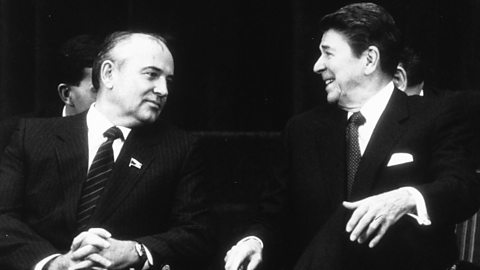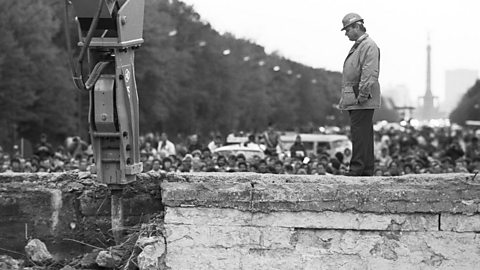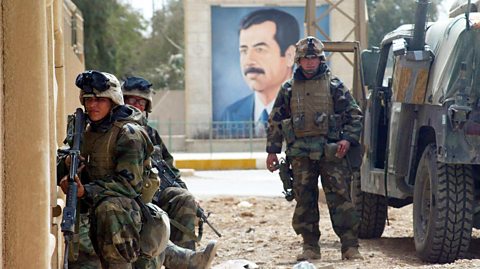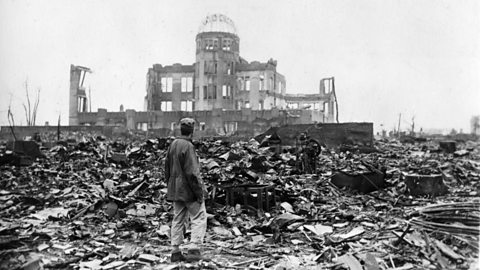Mikhail Gorbachev

The decline of communismA system of running a country in which all means of production such as tools, factories and raw materials, are owned by the community as a whole. Private property does not exist and each individual contributes according to their ability and receives according to their needs. This means there is no hierarchy of social class. was not a result of American policies and the Cold WarThe political tension and competition for power that existed between the communist East and the democratic West after World War Two. The two sides did not ever go to war. , but more to do with the problems faced by the USSR at home and abroad.
In March 1985, Mikhail Gorbachev was elected as leader of the USSR.
He was one of a new generation of well-educated communists who were too young to remember the grim pre-war years under Stalin.
Gorbachev recognised many of the key problems in the USSR and he was determined to introduce reforms.

Question
What were the problems facing the USSR in the 1980s?
- The Soviet economy was in trouble. It had been drained by the war in Afghanistan and many of its industries were out of date. It could not afford the enormous costs of the Cold WarThe political tension and competition for power that existed between the communist East and the democratic West after World War Two. The two sides did not ever go to war. .
- Social problems, such as crime, as well as drug and alcohol abuse, were increasing.
- The USSR was decades behind the USA technologically.
- Living standards were very low and there were severe food shortages. Unrest was increasing.
- The Soviet system had become corruptWhen a person, company or country acts in a dishonest way for their own personal gain. and out of date.
Glasnost and Perestroika
In 1985, Gorbachev tried to reform the USSR by introducing two new policies, Glasnost and Perestroika.
Question
What was Perestroika?
This meant ÔÇśrestructuringÔÇÖ and involved reducing state control of industry and allowing free enterpriseA system in which private business operates mainly without government intervention or control..
Question
What was Glasnost?
This meant ÔÇśopennessÔÇÖ and was focused on ending state corruption and allowing freedom of speech.
Furthermore, Gorbachev also ended the Brezhnev DoctrineThe Soviet UnionÔÇÖs policy of sending troops into communist countries against people who opposed those governments. ÔÇô telling the Eastern blocCountries in Eastern Europe that were controlled by the Soviet Union, for example Poland, Hungary and Czechoslovakia.states in March 1989 that the Soviet Army would no longer support them.
He realised that the USSR could not afford the arms raceWhen nations compete to have the most or best weapons. with the US anymore and instead opened the START 1 (Strategic Arms Reduction Talks) with the USA.
He also signed the Intermediate Nuclear Forces Treaty in 1987 which called for all short and medium-range nuclear weaponAn extremely powerful explosive device that gets its energy from nuclear reactions. Nuclear weapons are much more powerful than even the largest non-nuclear bomb. Their explosions are so powerful that just one nuclear weapon is capable of completely destroying a city. Nuclear weapons also release huge amounts of radiation, which causes terrible illnesses for a very long time after the initial explosion. to be dismantled, and pulled out of Afghanistan in 1989.
The role of Ronald Reagan

In 1980, Ronald Reagan was elected President of the United States.
He was a committed anti-communist who referred to the Soviet Union as ÔÇśthat evil empire'.
He actively began a new Cold WarThe political tension and competition for power that existed between the communist East and the democratic West after World War Two. The two sides did not ever go to war. ; doubling US defence spending, deploying cruise missileA missile guided towards its target by a computer system. in Europe and developing the neutron bombA type of nuclear weapon that uses radiation. It is fatal to people but does not damage buildings..
In 1983, work started on the Strategic Defence Initiative (known as "Star Wars") which was a plan for destroying Soviet missiles in flight by firing lasers at them from space.
However, in reaction to GorbachevÔÇÖs actions, Reagan soon moved to a position of negotiation with the USSR and engaged in Strategic Arms Reduction Talks (START 1) with them.
In 1987, the two superpowerCountries who have huge influence or strength, giving them significant global power. signed a deal to limit the production of intermediate range nuclear missiles.
The collapse of communism in Eastern Europe
Gorbachev hoped that his reforms would ÔÇśsaveÔÇÖ the USSR and keep the ruling Communist Party in power.
Instead, they unleashed a flood of unrest and a desire for change in Eastern Europe.
Like the domino theoryAn American belief that if one country became communist, others would quickly follow; like a row of dominoes falling down and knocking each other over. in reverse, country after country in Eastern Europe secured their independence from the USSR.
| Month/Year | Location | Event |
|---|---|---|
| January 1989 | Hungary | Following years of disappointment with communismA system of running a country in which all means of production such as tools, factories and raw materials, are owned by the community as a whole. Private property does not exist and each individual contributes according to their ability and receives according to their needs. This means there is no hierarchy of social class., Hungarians began to dismantle the barbed wire barriers between themselves and Austria. A non-communist government was set up. |
| June 1989 | Poland | After years of protest against communism, led by the Solidarity Trade Union, free elections in Poland in 1989 brought the Solidarity leader, Lech Walesa, to power. |
| October and November 1989 | East Germany | There were mass demonstrations and the East German leader, Erich Honecker, tried to crack down on the protestors. The demonstrations continued but Gorbachev refused to send Soviet troops to support Honecker. Honecker resigned and the Berlin Wall was opened and then later removed in 1990, starting the process towards the reunification of Germany. |
| November 1989 | Czechoslovakia | The communist regime was overthrown with almost no loss of life. |
The fall of the Berlin Wall
The most dramatic event during this period for people in the West was the fall of the Berlin Wall.
It was the symbol of the Iron CurtainA phrase used by Winston Churchill to describe the division in Europe between the communist east and capitalist west. and a lasting reminder of the division of Germany and its importance in the Cold WarThe political tension and competition for power that existed between the communist East and the democratic West after World War Two. The two sides did not ever go to war. .

The fall of the wall gave hope to others fighting to end communismA system of running a country in which all means of production such as tools, factories and raw materials, are owned by the community as a whole. Private property does not exist and each individual contributes according to their ability and receives according to their needs. This means there is no hierarchy of social class. and sped up the pace of change across Eastern Europe.
While the communist regimes of Eastern Europe collapsed, the Soviet Union did not intervene.
In 1990 and 1991, one by one the former Soviet Republics of the USSR (Lithuania, Latvia, Estonia, and Georgia) declared themselves independent.
Even Russia declared itself a republic in 1991, and elected Boris Yeltsin as its leader.
The Cold War ends
Gorbachev and Reagan had held a series of summit meetings which saw both sides agree to a reduction in weaponry.
This was contained in the 1987 Intermediate Nuclear Forces Treaty.
Soon after this, Gorbachev announced the withdrawal of Soviet forces from Afghanistan and a huge reduction in the size of the Soviet armed forces.
Troops were also withdrawn from other Iron CurtainA phrase used by Winston Churchill to describe the division in Europe between the communist east and capitalist west.countries.
US President George H W Bush met with Gorbachev in Malta in 1989 and both leaders declared the Cold WarThe political tension and competition for power that existed between the communist East and the democratic West after World War Two. The two sides did not ever go to war. to be over.
In July 1991, the Warsaw PactA collection of 12 communist countries that agreed to defend each other if one of them was attacked.was dissolved.
Test your knowledge
More on International relations, 1945-2003
Find out more by working through a topic
- count12 of 13

- count13 of 13

- count1 of 13
